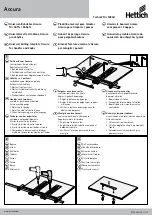
16
PLUNGE CUTTING
See Figures 14, 15, and 16.
WARNING:
To avoid loss of control, broken blades, or damage to
the material being cut, always use extreme caution when
making plunge cuts. We do not recommend plunge cutting
on materials other than wood.
TO MAKE A PLUNGE CUT
n
Mark the line of cut clearly on the workpiece.
n
Set the orbit adjustment to “0”.
n
Tilt the saw forward so that it rests on the front edge of the
base and blade will not come in contact with the workpiece
when the saw is turned on.
n
Make sure the blade is inside the area to be cut.
n
Using high speed, start the saw and slowly lower the blade
into the workpiece until the blade cuts through the wood.
See Figure 14.
n
Continue lowering the blade into the workpiece until the
base rests flat on the work surface, then move the saw
forward to complete the opening.
n
Use only the 7 teeth per inch blade for this type of cut.
METAL CUTTING
NOTE:
The jig saw has to be in the no-orbit mode to cut metals
and conduit. Set the orbital adjustment knob to "0".
Many kinds of metals can be cut with the saw. Be careful not
to twist or bend the blades. Do not force. If the blade chatters
or vibrates excessively, use a finer-tooth metal-cutting blade.
If blade heats excessively, use lower speed. If blade teeth
become filled or clogged when cutting soft metals, such as
aluminum, use a coarser-tooth blade or lower speed. We
recommend use of oil when cutting metals to keep blades
cool, increase cutting action, and prolong blade life. Clamp the
work firmly and saw close to the clamping point to eliminate
any vibration of the work being cut.
When cutting conduit, pipe or angle iron, clamp work in a vise if
possible and saw close to the vise. To cut thin sheet materials,
"sandwich" the material between hardboard or plywood and
clamp the layers to eliminate vibration and material tearing.
By doing this, the material will be cut smoothly. Lay out your
pattern or line of cut on top of the "sandwich."
NOTE:
When cutting metal, keep exposed portion of saw bar
clean and free of metal chips by wiping frequently with an
oily cloth. Use extreme caution in disposing of oily cloth after
completion of job to prevent potential fire hazard.
OPERATION
Fig. 14
Fig. 15
Fig. 16
Содержание Jig Saw
Страница 19: ...19 NOTES...





































